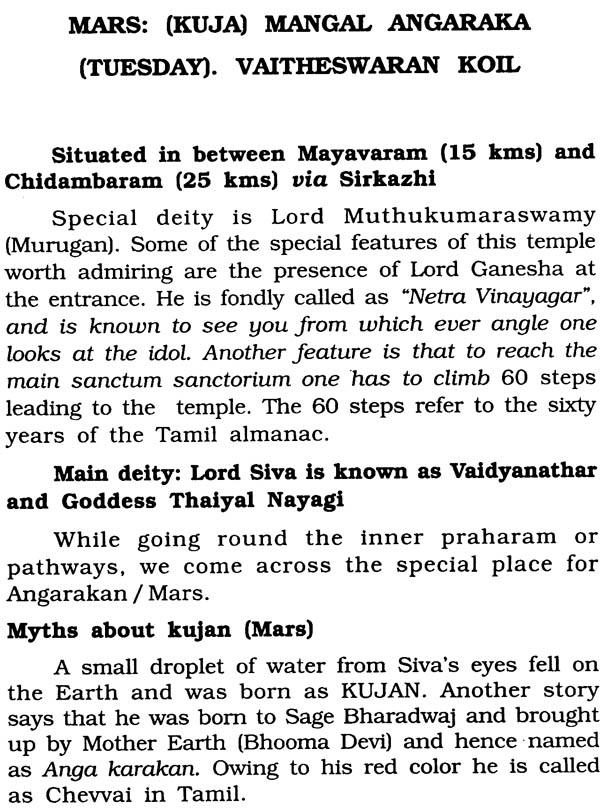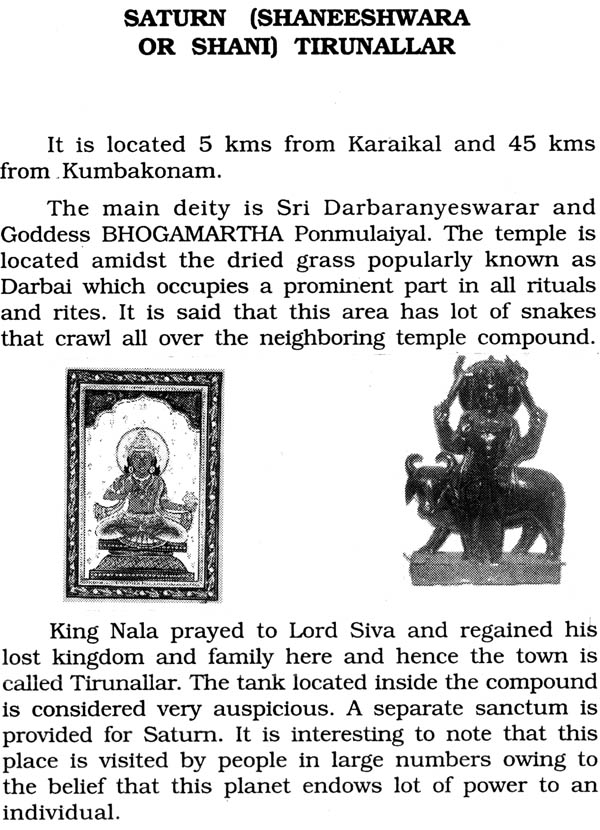
Navagraha Temples of Tanjore District of Tamil Nadu
Book Specification
| Item Code: | IDH562 |
| Author: | Vatsala Jambunathan |
| Publisher: | Bharatiya Vidya Bhavan |
| Edition: | 2011 |
| ISBN: | 9788172764531 |
| Pages: | 45 |
| Cover: | Paperback |
| Other Details | 8.5" X 5.5" |
| Weight | 70 gm |
Book Description
From the Back of the Book
The author, Smt. Vatsala Jambunathan is an educationist with wide experience of teaching and research. She has acquired a number of Degrees of Post Graduate level in Geography. Education, distance Education and is also the proud recipient of NCERT award in the year 1993.
She combines her interest in diverse fields like education, Astrology, Astronomy and Tourism.
She is widely traveled, both in India and Abroad. Her extra-curricular activities include sports, music, yoga and Dance, besides her knowledge of computers and versification. Married to an IAS officer of Maharashtra Cadre. She is the mother of three children and a grand mother of two.
I am happy to note the interest and enthusiasm with which Vatsala Jambunathan has worked on this booklet on Navagraha Temples of Tanjore district of Tamil Nadu.
I have known the Jambunathan family and their interest in academic and educational activities, besides their association with social, cultural, religious pursuits. Vatsala has been contribution articles for leading newspapers, that include articles on education and visit to places within India and abroad. She has a flair for writing in a travelogue from.
In this booklet, the author has made every attempt to bring out the salient features of these temple towns in a simple style so that her readers enjoy the descriptions on reading this book. She has done extensive research by reading, internet surfing besides her visit to these temple with her husband and gathering first hand information from the local priest and executive officers about the importance of each of these Navagraha.
I am privileged to go through the contents. She has taken the readers on a tour of the temple and also explained their importance, through her lucid comparison from an Astronomical, Astrological, Archaeological and cultural points of view. Those who read it, will certainly come to know more about the Navagraha (planets) and their influence on humanity.
I wish her all best in her endeavor.
Living in Maharashtra, since my marriage, I have visit many temple in several districts where my husband headed the District as collector. We have seen Tuljapur, Pandharpur, Drishnaeshwar, Bhimashankar, Shirdi etc. I have also been to a few of the Ashtavinayak temples.
In November 2000, I had the opportunity of visiting Shani Shingnapur, 70kms form Shirdi in Rahuri Taluka of Ahmehdnagar District, where a temple for Saturn or Shani has gained importance in recent years.
I have read and heard stories about this place. It is usually referred to as “a village, with houses having no doors” where all belongings are kept as they are, and the belief is that Shani or Saturn, one of the important Navagraha, takes care of the people and their possessions.
This rounds my curiosity to know more about the Navagraha Temples of Tanjore district in Tamil Nadu. This is also a region form where we hail and we made plans to visit the same.
The National book Trust had organized a book fair in December 2000 in Mumbai. I came across a few of the books pertaining to our trip which were in Tamil. I was keen to read a few articles in English, but none was available except for a small write up in the temple office. This made me think about attempting a booklet in English for the benefit of my children and friends who were eager to share my experiences about out visit to the Navagraha Temples.
Being interested in the study of Astronomy, Astrology and Geography, it further kindled my interest and to read about them a different perspective.
I think my husband who has been a great source of inspiration in encouraging me to write and helping with manuscript correcting. My daughter’s help has been immense and I thank her for the same.
I would also like to thank Nilima and Dilip Halbe foe scanning the photographs and pictures. To other friends who have helped me by getting reference materials form old magazines, their timely contributions have been invaluable
My thanks to the Bhartriya Vidya Bhavan and its Executive Secretary and Director General Shri S. Ramakrishna who have considered my article for publication to help the public get a booklet about the Navagraha.
Lastly, I wish to thank Shri P. V. Sankarankutty and his team who have painstakingly formatted the final version and made it ready for publication.
My husband and I decided to go on a sight seeing-cum pilgrimage tour of Tanjore district especially to see the Navagraha Temples at leisure and appreciate the ancient art and heritage of Tamil Nadu. I had heard from several friends anecdotes about their Visits to one or two temples, but we decided to visit them all in three days. A long awaited trip was realized in January 2001. Having visited the six abodes of Murugan or Karthikeya, the Nav-Tirupathy (nine temple of Vishnu) in Triunelveli Disitrict, we were desirous of seeing the nine temples specially dedicated to each one of the nine plants in and around Tanjore District.
A simple route map containing the distance to the temples from Kumbakonam helped plan the trip carefully. This gave us enough time to see and appreciate the works of the great Chola kings.
Tanjore district in Tamil Nadu is called the “Rice Bowl or Granary of South India.” This region is famous for the BRIHADEESWARA temple at Tanjore, and the annual Music Festival of Saint Thyagaraja which is held at Thiruvaiyaru, on the banks of the Cauvery river. The Navagraha temples are located on the southern and northern banks of this great river and several temple town have gained prominence in the recent years owing to the location of these temples.
Each of these nine temples, some big, some small, is important in its own right, Archaeological evidence suggest that they been built during the reign of the Chola and Pandya kings. The temples are built according to the Agama Shastras and are maintained either by the Hindu Religious Endowment Board or the Tamil Nadu Saiva Adhinams (Trusts). As important tourist destinations, the Tamil Nadu Tourism Department is also involved in its maintenance.
Each of the nine navagraha temples is dedicated to one of the nine principle plants which influence the Earth. They are as follows :
Mercury, Venus, Earth, Mars, Jupiter, Saturn, Uranus, Neptune and Pluto.
The sentence “MY VERY EXCELLENT MOTHER JUST SHOWED US NINE PLANTES helps us remember their order. The underlined first latter of each word stands for their position from the Sun (nearest to the farthest).
They all revolve round the Sun and from members of the Solar System. It is fascinating to observe how these celestial bodies moving around in specific paths are constantly shaping the life on Earth, of all organisms including man. According to Hindu scriptures only the first seven plants are regarded as part of Navagraha and have found a specific place of worship.
The last two are called dragons and are considered shadow planets. They traverse the orbit in a reverse motion while the other plants travel in a forward motion. It is believed that all the planets influence and shape the destiny of man.
These pantheon of Gods have occupied a place in the annals of our religious and cultural history. They gained importance in the recent years, when during the celestial dance of the conjunction of planets, scientists made a study of their influence on living organisms. A lot of study has been done from different points of view about the planets, their motion and their influence on man.
| Foreword | v | |
| Preface | Vii | |
| 1.0 | Introduction | 1 |
| 2.0 | Names as seen in Astrology and Astronomy | 4 |
| 3.0 | Location and general information | 7 |
| 4.0 | Temple towns dedicated to the 9 planets | 11 |
| 5.0 | Guide to the tourist location around | 35 |
| Appendix | ||
| I | Navagraha Sthothram | 36 |
| II | Navagraha Gayatri | 39 |









